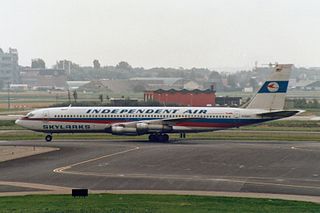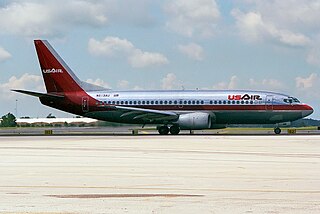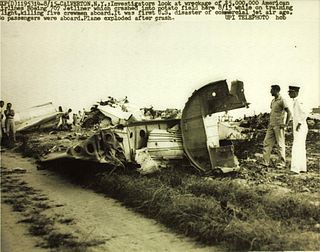
Pan Am Flight 214 was a scheduled flight of Pan American World Airways from Isla Verde International Airport in San Juan, Puerto Rico, to Friendship Airport near Baltimore, and then to Philadelphia International Airport. On December 8, 1963, while flying from Baltimore to Philadelphia, the Boeing 707-121 serving the flight crashed near Elkton, Maryland. All 81 occupants of the plane were killed. The crash was Pan Am's first fatal accident with the 707, which it had introduced to its fleet five years earlier.

Continental Airlines Flight 11, registration N70775, was a Boeing 707 aircraft which exploded in the vicinity of Centerville, Iowa, United States, while en route from O'Hare Airport, Chicago, Illinois, to Kansas City, Missouri, on May 22, 1962. The aircraft crashed in a clover field near Unionville, in Putnam County, Missouri, killing all 45 crew and passengers on board. The investigation determined the cause of the crash was a suicide bombing, committed as insurance fraud.

Flying Tiger Line Flight 739 (FT739/FTL739) was a Lockheed L-1049 Super Constellation propliner that disappeared on March 16, 1962, over the western Pacific Ocean. The aircraft, which had been chartered by the United States Army, was transporting ninety-six military passengers from Travis Air Force Base in California to Tan Son Nhut International Airport in Saigon, South Vietnam. After refueling at Andersen Air Force Base in Guam, the Super Constellation disappeared while en route to Clark Air Base in the Philippines. All 107 aboard were declared missing and presumed dead.

Eastern Air Lines Flight 663 was a domestic passenger flight from Boston, Massachusetts, to Atlanta, Georgia, with scheduled stopovers at John F. Kennedy International Airport, New York; Richmond, Virginia; Charlotte, North Carolina; and Greenville, South Carolina. On the night of February 8, 1965, the aircraft serving the flight, a Douglas DC-7, crashed near Jones Beach State Park, New York, just after taking off from JFK Airport. All 79 passengers and five crew aboard died.

American Airlines Flight 383 was a nonstop flight from New York City to Cincinnati on November 8, 1965. The aircraft was a Boeing 727, with 57 passengers, and 5 crew on board. The aircraft crashed on final approach to the Cincinnati/Northern Kentucky International Airport located in Hebron, Kentucky, United States. Only three passengers and one flight attendant survived the crash.

Pakistan International Airlines Flight 740 was a Hajj pilgrimage flight from Kano, Nigeria to Karachi, Pakistan with an intermediate stopover in Jeddah, Saudi Arabia. Operated by Pakistan International Airlines, on 26 November 1979, the Boeing 707-340C serving the route crashed shortly after takeoff from Jeddah International Airport. All 156 people on board were killed.

Northeast Airlines was an American trunk carrier, a scheduled airline based in Boston, Massachusetts that chiefly operated in the northeastern United States, and later to Canada, Florida, the Bahamas, Bermuda and other cities. It was notably small and unprofitable relative to other trunk carriers, being less than half the size, by revenue, than the next biggest trunk in 1971. Northeast was acquired by and merged into Delta Air Lines in August 1972.
Aircraft upset is an unacceptable condition, in aircraft operations, in which the aircraft flight attitude or airspeed is outside the normally intended limits. This may result in the loss of control (LOC) of the aircraft, and sometimes the total loss of the aircraft itself. Loss of control may be due to excessive altitude for the airplane's weight, turbulent weather, pilot disorientation, or a system failure.

On July 1, 1965 Continental Airlines Flight 12 overran the runway while attempting to land at Kansas City Municipal Airport. No one was killed or seriously injured, but the accident forced discussions about runway safety in Kansas City and resulted in construction of a new airport, Kansas City International Airport, which opened in 1972. The accident also led to widespread implementation of runway grooving, which improves braking in wet landing conditions.

On September 8, 1974, a Boeing 707-331B operating as TWA Flight 841 from Tel Aviv to New York City via Athens and Rome crashed into the Ionian Sea, killing all aboard. The National Transportation Safety Board determined that the plane had been destroyed by a bomb hidden in the cargo hold. The detonation of the bomb destroyed the systems responsible for operating the plane's control surfaces, causing the plane to pitch up until it stalled and dove into the sea.

On 8 February 1989, Independent Air Flight 1851, a Boeing 707 on an American charter flight from Bergamo, Italy, to Punta Cana, Dominican Republic, struck Pico Alto while on approach to Santa Maria Airport in the Azores for a scheduled stopover. The aircraft was destroyed, with the loss of all 144 people on board, resulting in the deadliest plane crash in Portugal's history. All of the passengers on board were Italian and all of the crew were Americans. The crash is also known as "The disaster of the Azores".

Pan Am Flight 812 (PA812), operated by a Pan American World Airways Boeing 707-321B registered N446PA and named Clipper Climax, was a scheduled international flight from Hong Kong to Los Angeles, California, with intermediate stops at Denpasar, Sydney, Nadi, and Honolulu. The airplane briefly appeared in the Willy Wonka and the Chocolate Factory movie in 1971. On April 22, 1974, it crashed into rough mountainous terrain while preparing for a runway 09 approach to Denpasar after a 4-hour 20-minute flight from Hong Kong. All 107 people on board perished. The location of the accident was about 42.5 nautical miles northwest of Ngurah Rai International Airport. Until the 1991 Jakarta Indonesian Air Force C-130 crash, it was the deadliest aviation accident to happen on Indonesian soil.

USAir Flight 427 was a scheduled flight from Chicago's O'Hare International Airport to Palm Beach International Airport, Florida, with a stopover at Pittsburgh International Airport. On Thursday, September 8, 1994, the Boeing 737 flying this route crashed in Hopewell Township, Pennsylvania while approaching Runway 28R at Pittsburgh, which was USAir's largest hub at the time.

Northwest Airlines Flight 421 was a domestic scheduled passenger flight from Chicago, Illinois to Minneapolis, Minnesota that crashed on 29 August 1948. The Martin 2-0-2 aircraft, operated by Northwest Airlines, suffered structural failure in its left wing and crashed approximately 4.1 miles (6.6 km) northwest of Winona, Minnesota, about 95 miles (153 km) southeast of Minneapolis. A Civil Aeronautics Board investigation determined that the crash was caused by fatigue cracks in the wings of the aircraft, and recommended lower speeds and frequent inspections of all Martin 2-0-2 aircraft. All 33 passengers and 4 crewmembers on board were killed. The crash was the first loss of a Martin 2-0-2, and remains the worst accident involving a Martin 2-0-2.

American Airlines Flight 28 was a scheduled domestic passenger flight that crashed on October 23, 1942, in Chino Canyon near Palm Springs, California, United States, after being struck by a United States Army Air Forces B-34 bomber. The B-34 suffered only minor damage, and landed safely at the Army Airport of the Sixth Ferrying Command, Palm Springs.

The Boeing 720 was an American narrow-body airliner produced by Boeing Commercial Airplanes. Announced in July 1957 as a 707 derivative for shorter flights from shorter runways, the 720 first flew on November 23, 1959. Its type certificate was issued on June 30, 1960, and it entered service with United Airlines on July 5, 1960. A total of 154 Boeing 720s and 720Bs were built until 1967. As a derivative, the 720 had low development costs, allowing profitability despite few sales.

American Airlines Flight 514 was a training flight from Idlewild International Airport, to the Grumman Aircraft Corp. airfield. On the afternoon of August 15, 1959, the Boeing 707 operating the flight crashed near the Calverton airport, killing all five crew members aboard. This was the first accident to involve a Boeing 707, which had only gone into service in October of the previous year, and the first of three accidents involving American's 707s in the New York area within three years, followed by Flight 1502 and Flight 1.
















